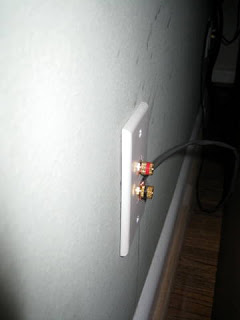A few years ago my house was broken into, thankfully nothing was taken but the would be thieves left the door open. We’re sure we didn’t leave it open as it’s a door we never used and our neighbors noticed an unfamiliar car in our driveway.
We think Harley, our, thirty-five pound labradoodle scared them off. He’s normally locked in the basement, and if you can’t see him, his bark can be ferocious.
 |
| FEAR THE BEAST |
My wife got home before me and called the police. They came quickly (under 5 minutes) and swept the house to make sure there wasn’t anyone inside. When they opened the door to the basement, our ferociously barking guard dog ran the other way, deeper into the basement. I rescued him from the backyard after he escaped through the dog door.
Make the home harder than the one next to it.
As you can imagine this really upset us and so we looked into what we can do to secure our home. There’s an old joke: “How do you out run a bear?” A: You don’t, you just have to outrun the guy next to you. This was our strategy to home safety, we decided to make our house harder to get into than the ones next to us.
The first thing I did was replace the rear door and the side door (the one that was used to break in) with modern doors that opened outward.
The reason to make the door open outward is because it’s almost impossible to kick a door in if it opens out. If you are going to make a door open out make sure you use armored pins in the hinges. With the door opening out, the hinges are now on the outside of the house. A traditional pin can be pulled out of the door without opening the door. An armored pin is protected from removal when the door is closed.
We also replaced all of the screws connecting the door frame to the house with 3″ (or longer) screws that connected the door frame to the studs in the walls next to the door. In standard construction, the door is connected to the door frame, and the door frame is attached to the house. If you’re not careful, the door frame won’t be tightly connected to the studs, if that’s the case then a bad guy with a crowbar can pry the door frame away from the house.
This cost us about $2,500. Two custom wooden doors plus labor to install them.
Second thing I did was put the front porch light on an astronomical timer. These are marevelous devices that take your latitude and longitude into account and calculate sundown and sunrise every day. I programmed mine to turn on 20 minutes before sunset and turn off 20 minutes after sunrise. This switch combined with an energy efficient bulb means my front and side door are well illuminated at night.
Here’s the switch I have: Honeywell Econoswitch. Under $40, easy to justify.
Third thing I did was make sure all street visible windows are covered with blinds. Price here varies, but a temporary shade is as little as $10.00.
Fourthly, we put some lights on timers so that the house looks occupied. I like this one because it allows you to set a random jitter. This will prevent the light from turning on and turning off at the exact same time every night.
Fifthly, I added a motion sensing light to the back yard, it’s a three bulb 300 watt beast that makes the entire back yard glow if the motion sensor is triggered.
Lastly, don’t underestimate the dogs. Our dogs may be small and adorable, but if you can’t see them, they sound fierce. I don’t know that security is the best reason to get a dog, but it is a nice benefit to having one (or two).
What else are we thinking about doing?
We’re looking at doing two more things, I want to add two more motion sensor lights, one to each side of the house as the sides are a little darker than I’d like.
We’re also going to investigate adding security film to our windows, the film is amazing in video, and should keep a bad guy from breaking a window to get in.
The video is really amazing and speaks for itself:
A burglar won’t want to do that for very long, it’s a very loud and very distinctive sound.
What about an alarm?
We briefly thought about an alarm but decided against it for a few reasons:
- The police officer who responded said that the average burglar is in a home for about 8 minutes. I doubt the response time from alarm going off to police on site will be under 8 minutes.
http://simplisafe.com/blog/burglar-universal-search-pattern-how-burglar-robs-your-home-8-minutes
- There isn’t a good solution for false alarms, and with two dogs, false alarms could be a real problem. In Seattle, you pay $115 per false alarm.
http://www.seattle.gov/police/programs/alarms/default.htm
- They’re expensive, and reactionary. If the alarm has gone off, the bad guy is already inside.
- I don’t actually believe they prevent burglaries, no data on this, I just don’t buy it.










